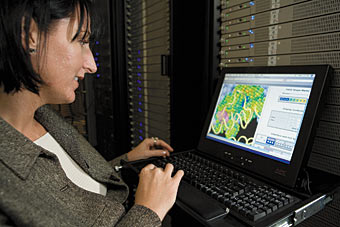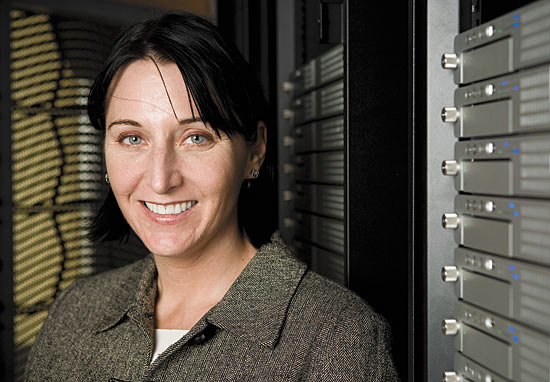Bridging the divide between math and biology
As a mathematician who has navigated the field of biology for nearly a decade, mathematics professor Julie Mitchell has some sage advice for those who choose to follow. Never hesitate to ask a “dumb” question. Don’t be afraid to admit you don’t know something. Meanwhile, show some bravado.
Most of all: Don’t let biology’s unpredictability drive you insane.
“I think it takes a special personality,” laughs Mitchell, who is also a biochemistry professor.
“What drew me to proteins in the first place was their interesting shapes. And then there were partial differential equations and dynamical systems that went along with these fascinating geometric structures. And from that point on, that was what I was doing.”
Julie Mitchell
Yet for those like her, who are willing to brave a little uncertainty, the opportunity to help solve some of biology’s most intractable problems is huge. Even before arriving at UW–Madison as part of the Cluster Hire Initiative in 2003, Mitchell was collaborating with biochemistry professor Ron Raines on research that eventually produced a potential new cancer drug.
She has since created an enhanced computational tool with graduate student Steve Darnell and biostatistics professor David Page that predicts how the surfaces of proteins interact during binding — information that biologists can then use to engineer “designer” molecules with specific functions.
And most recently, Mitchell directs UW–Madison’s institute named Bringing Advanced Computational Techniques to Energy Research, or BACTER. The institute has signed on with the new Great Lakes Bioenergy Research Center, which aims to explore the untapped potential of biofuels.
With each new project, Mitchell’s goal remains the same: to give biologists a fresh look at their systems. For its ability to reveal the otherwise invisible worlds inside many types of biological data, mathematics has been called the next microscope.
“For years, many parts of biology have pretty much been descriptive sciences,” says bacteriology professor and bioenergy center director Tim Donohue. “What Julie brings is a quantitative approach to looking at biological pathways and protein structure and function that is critical to understanding how biological systems work.”
Not bad for someone who claims the word “protein” once meant little more to her than an ingredient on the back of a cereal box.
“Honestly, before I started on this quest, I didn’t know there was more than one kind of protein, such as antibodies or enzymes. It was kind of this generic, singular thing,” says Mitchell. “Since then, I’ve come to understand the diversity of the world of proteins and all the important functions they perform.”

Assistant professor of mathematics and biochemistry Julie Mitchell looks at a computer rendering of a protein molecule on a server workstation inside Van Vleck Hall. Mitchell, along with her colleagues Steve Darnell and David Page (not pictured), have created an enhanced computational tool that predicts how the surfaces of proteins interact during binding.
Photo: Bryce Richter
In this, she’s not alone: The entire field of mathematics has been slow to appreciate the life sciences — and vice versa. While mathematics and physics have been married from the start, math and biology are seemingly still in the courtship phase, getting to know one another and figuring out how to relate. It’s not surprising given how different they are, Mitchell says.
“In many ways, mathematics and biology are almost logical opposites,” she says. “Mathematics is more of an art: You create rules for some geometric or algebraic space and then see what you can prove about it. In biology, we can’t even figure out what some of the basic rules are. There are no theorems. Everything has a little asterisk next to it that says, ‘Except in the following cases.’”
Still, as a new mathematics Ph.D. looking to sharpen her skills on some real-world problems, Mitchell says that biology — and especially protein biochemistry — exerted an irresistible pull.
“What drew me to proteins in the first place was their interesting shapes,” Mitchell says. “And then there were partial differential equations and dynamical systems that went along with these fascinating geometric structures. And from that point on, that was what I was doing.”
Fueled by that excitement, Mitchell began the hard work of learning to think more like a biochemist. At the same time, she used her expertise in geometrical analysis to develop a computational tool called FADE. FADE analyzes the shape of the interface between proteins when they are locked together in a complex, such as when an enzyme binds its substrate. Among the nooks and crannies of this surface, the program hunts for “hotspots,” where swapping an existing amino acid for another will spoil the fit and weaken or break the interface.
Biochemists can then test FADE’s predictions by making mutations at the hotspots to see if bond strength is indeed diminished, just as Mitchell and Raines did in their first collaboration together. By adding hotspot predictions from FADE to their own knowledge of protein chemistry, Raines and his lab group were able to disrupt the interaction between an enzyme and another protein that normally inhibits it, transforming the enzyme into a potent anticancer agent.
The work subsequently led to a patent through the Wisconsin Alumni Research Foundation — much to Mitchell’s amazement.
“I never would have imagined in a million years as a mathematics graduate student that I would end up on a patent for a new cancer drug,” she says. “It seems unfathomable: What, as a mathematician, can one do that’s going to have that kind of impact? It’s exactly the type of thing that I went into this field to do.”
With biostatistician Page and her student Darnell, she has since integrated FADE into a more powerful hotspot predictor known by a catchy acronym, the KFC server. Easily worked by anyone with Internet access, it has already attracted scores of users around the world since debuting last year.
Lately, Mitchell, Darnell and oncology professor Michael Hoffmann have turned the tables to tackle a much tougher problem: forecasting hotspots where targeted mutations will cause proteins to bind to one another more tightly, rather than break apart.
From here, the opportunities seem as limitless as the universe of proteins itself, especially now, when structural biologists are solving the molecular structures of proteins at unprecedented rates.
“The structure of a naked protein is important, but it’s just the beginning of the story,” says Raines. “If we really want to understand the biology, we need to know how these proteins interact with one another. And so, Julie’s intent is to help investigators take the next steps.”





